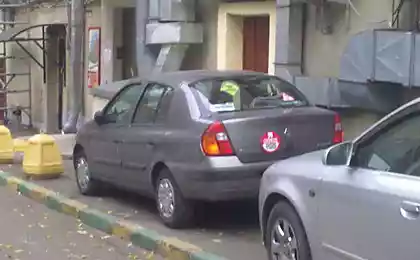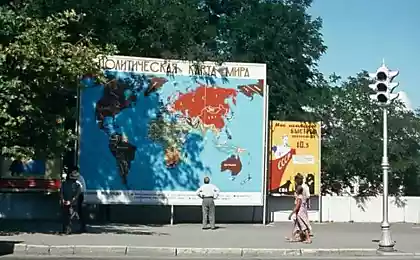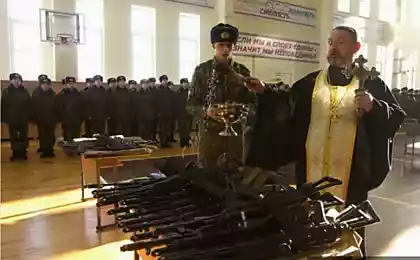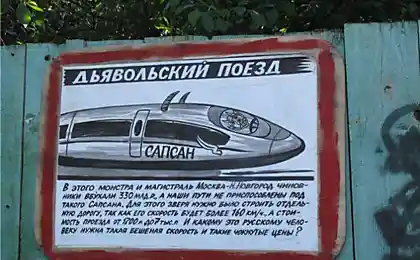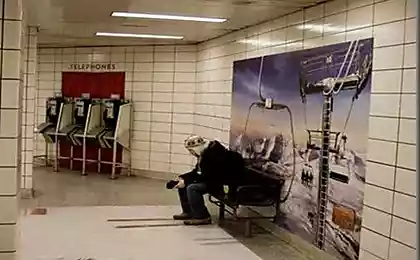878
Visual agitation
tema writes on LiveJournal:
Visual agitation in the USSR was very monotonous. Communist shit, some handmade movie posters, neat metal neon letters on store signs.

The visual range was so dull that people could wear a foreign plastic bag for years - God forbid it breaks. Fantastic foreign gum was for schoolchildren currency. The gum itself is gold. My love for pre-revolutionary typography began with the filing of Niva magazine in 1903, which I exchanged for two plates of gum, which, in turn, I received as a rare gift from one of my relatives. There are no gums more than twice a year. The record itself was not chewed for five minutes - it was chewed for a couple of days until it began to decompose into ingredients. At night, the gum was put on the table, in the morning it was chewed again. She had no taste, but it was gum!
I still remember how my classmate, an excellent student by the name of Khoroshlov, at home watered a parrot with water from a buble-gum liner. He was in my eyes a major and a criminal. His parents worked somewhere in the trade.
But campaigning.
Moscow House of Books, 1967. Lenin, Brezhnev, portraits of the members of the Politburo in the set, a few posters about Komsomol members and builders, a little terrible graphics of some old farts - members of the Moscow State Committee.

Cinema "Art", the poster of the film. 1980. Note that no one dressed brightly, it was considered defiant. (And in the south, even men in the sanatorium were not allowed to wear shorts in the dining room - there was a scandal.)

The agitation of the canvas on the historical museum: “Long live Lenin’s peace-loving foreign policy of the USSR!”
Everyone from this style of superman image vomited, and in the West it was super cool. It turned out that all sorts of bourgeois factories, canteens and airports did not disdain to build panels in this style (or under great influence). In general, the scoop in the West turned out to be very much - in the scoop this could not think even in jokes.

On the other side. The image of Lenin with a fly swagger newspaper is very common. Every word on the posters is filled with deep meaning. Not just the peasantry, but the collective farm peasantry. The intelligentsia is the people. It's not the people's way of life.

The feat of the Presnen workers. In general, it is curious that no one cares about those who died during the revolution, and any mention of those who died during the Second World War (as the Second World War was called before perestroika) today fills souls with memories, and eyes with tears. That is, military feats seem modern. And before, they were just as sensitive to some underground man who died illegally printing leaflets for the Bolsheviks. 1986.
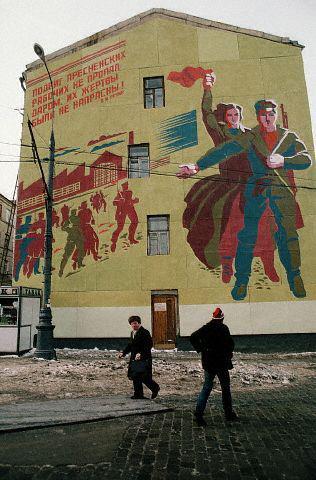
Nikitsky Gate Square. On the right is a studio shop. On the left is TASS. Instead of a leaven kiosk, now flowers, instead of Marxism-Leninism, a permanent exhibition of Loreal advertising. The area littered with snow is what the church has now enclosed with its fence, kicking off half the pavement.

Before the Bolshoi Theatre. 1986.

The end of the hotel "Moscow", which is now completely rebuilt. 1986. Even then, it seemed that the word “party” had only one meaning and could never have a second meaning. Turns out the language is alive.
An interesting image of a woman. In Soviet agitation there were several permitted female images. There was a girl - a schoolgirl; a girl - youth, study; something asexual - a friend, a colleague (just here painted); a woman of 50 years with a headscarf on her head or shoulders - a mother.

Festive decoration of the Bolshoi Theatre. 1986.

Next year, it’s almost the same. 1987.

It is hard to imagine how a whole country could live with all these slogans and portraits. No one was surprised, no one was bullied. Surely someone burned or threw a jar of ink in a painted Lenin, but he definitely ended up in a mental hospital.
Most of all, the employees of art and design combines were happy. They paid well, per square foot. 1987.

Another convention. 1987. Especially terrible are these baskets with flowers - so unmistakably Soviet. In the West, flowers still look foreign, and our stagnation in this industry is ineradicable.
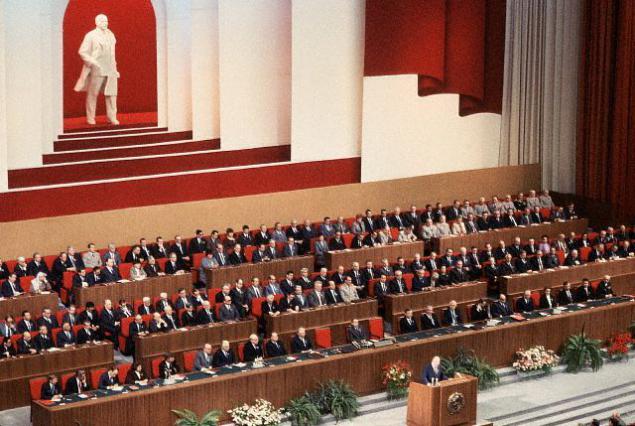
1990. A new environment. The opportunity for artists and designers to prove themselves, to throw off totalitarian shackles - but the entire old generation almost in full force went to the bottom. Because no one could work or think.

However, the 90s is the most graphically terrible period in the world, not only here. Computers appeared, everyone switched to them, and nobody could work for them. As much shit as in the '90s, never made.
1990. The first McDonald's opened. At that time, there were no jokes about the fact that you can go there to pee if the toilet is not closer. We waited in line for hours. There were special boys who made money by bringing orders to the bandits parked on the boulevard - such a proto-macavto. The first McDonald’s had a Soviet flag in its logo (in Canada it still has a Canadian flag). For the West, this was one of the most significant events. First, you could always take a picture of the line. The Soviet flag under the letter M is like opening a restaurant on the moon.

1991. The collapse of the USSR. The school painter was afraid to paint Lenin whole, went around. “The most human person” – no one’s ears from this shit did not wither, for some reason.

katoga
Visual agitation in the USSR was very monotonous. Communist shit, some handmade movie posters, neat metal neon letters on store signs.

The visual range was so dull that people could wear a foreign plastic bag for years - God forbid it breaks. Fantastic foreign gum was for schoolchildren currency. The gum itself is gold. My love for pre-revolutionary typography began with the filing of Niva magazine in 1903, which I exchanged for two plates of gum, which, in turn, I received as a rare gift from one of my relatives. There are no gums more than twice a year. The record itself was not chewed for five minutes - it was chewed for a couple of days until it began to decompose into ingredients. At night, the gum was put on the table, in the morning it was chewed again. She had no taste, but it was gum!
I still remember how my classmate, an excellent student by the name of Khoroshlov, at home watered a parrot with water from a buble-gum liner. He was in my eyes a major and a criminal. His parents worked somewhere in the trade.
But campaigning.
Moscow House of Books, 1967. Lenin, Brezhnev, portraits of the members of the Politburo in the set, a few posters about Komsomol members and builders, a little terrible graphics of some old farts - members of the Moscow State Committee.

Cinema "Art", the poster of the film. 1980. Note that no one dressed brightly, it was considered defiant. (And in the south, even men in the sanatorium were not allowed to wear shorts in the dining room - there was a scandal.)

The agitation of the canvas on the historical museum: “Long live Lenin’s peace-loving foreign policy of the USSR!”
Everyone from this style of superman image vomited, and in the West it was super cool. It turned out that all sorts of bourgeois factories, canteens and airports did not disdain to build panels in this style (or under great influence). In general, the scoop in the West turned out to be very much - in the scoop this could not think even in jokes.

On the other side. The image of Lenin with a fly swagger newspaper is very common. Every word on the posters is filled with deep meaning. Not just the peasantry, but the collective farm peasantry. The intelligentsia is the people. It's not the people's way of life.

The feat of the Presnen workers. In general, it is curious that no one cares about those who died during the revolution, and any mention of those who died during the Second World War (as the Second World War was called before perestroika) today fills souls with memories, and eyes with tears. That is, military feats seem modern. And before, they were just as sensitive to some underground man who died illegally printing leaflets for the Bolsheviks. 1986.

Nikitsky Gate Square. On the right is a studio shop. On the left is TASS. Instead of a leaven kiosk, now flowers, instead of Marxism-Leninism, a permanent exhibition of Loreal advertising. The area littered with snow is what the church has now enclosed with its fence, kicking off half the pavement.

Before the Bolshoi Theatre. 1986.

The end of the hotel "Moscow", which is now completely rebuilt. 1986. Even then, it seemed that the word “party” had only one meaning and could never have a second meaning. Turns out the language is alive.
An interesting image of a woman. In Soviet agitation there were several permitted female images. There was a girl - a schoolgirl; a girl - youth, study; something asexual - a friend, a colleague (just here painted); a woman of 50 years with a headscarf on her head or shoulders - a mother.

Festive decoration of the Bolshoi Theatre. 1986.

Next year, it’s almost the same. 1987.

It is hard to imagine how a whole country could live with all these slogans and portraits. No one was surprised, no one was bullied. Surely someone burned or threw a jar of ink in a painted Lenin, but he definitely ended up in a mental hospital.
Most of all, the employees of art and design combines were happy. They paid well, per square foot. 1987.

Another convention. 1987. Especially terrible are these baskets with flowers - so unmistakably Soviet. In the West, flowers still look foreign, and our stagnation in this industry is ineradicable.

1990. A new environment. The opportunity for artists and designers to prove themselves, to throw off totalitarian shackles - but the entire old generation almost in full force went to the bottom. Because no one could work or think.

However, the 90s is the most graphically terrible period in the world, not only here. Computers appeared, everyone switched to them, and nobody could work for them. As much shit as in the '90s, never made.
1990. The first McDonald's opened. At that time, there were no jokes about the fact that you can go there to pee if the toilet is not closer. We waited in line for hours. There were special boys who made money by bringing orders to the bandits parked on the boulevard - such a proto-macavto. The first McDonald’s had a Soviet flag in its logo (in Canada it still has a Canadian flag). For the West, this was one of the most significant events. First, you could always take a picture of the line. The Soviet flag under the letter M is like opening a restaurant on the moon.

1991. The collapse of the USSR. The school painter was afraid to paint Lenin whole, went around. “The most human person” – no one’s ears from this shit did not wither, for some reason.

katoga


